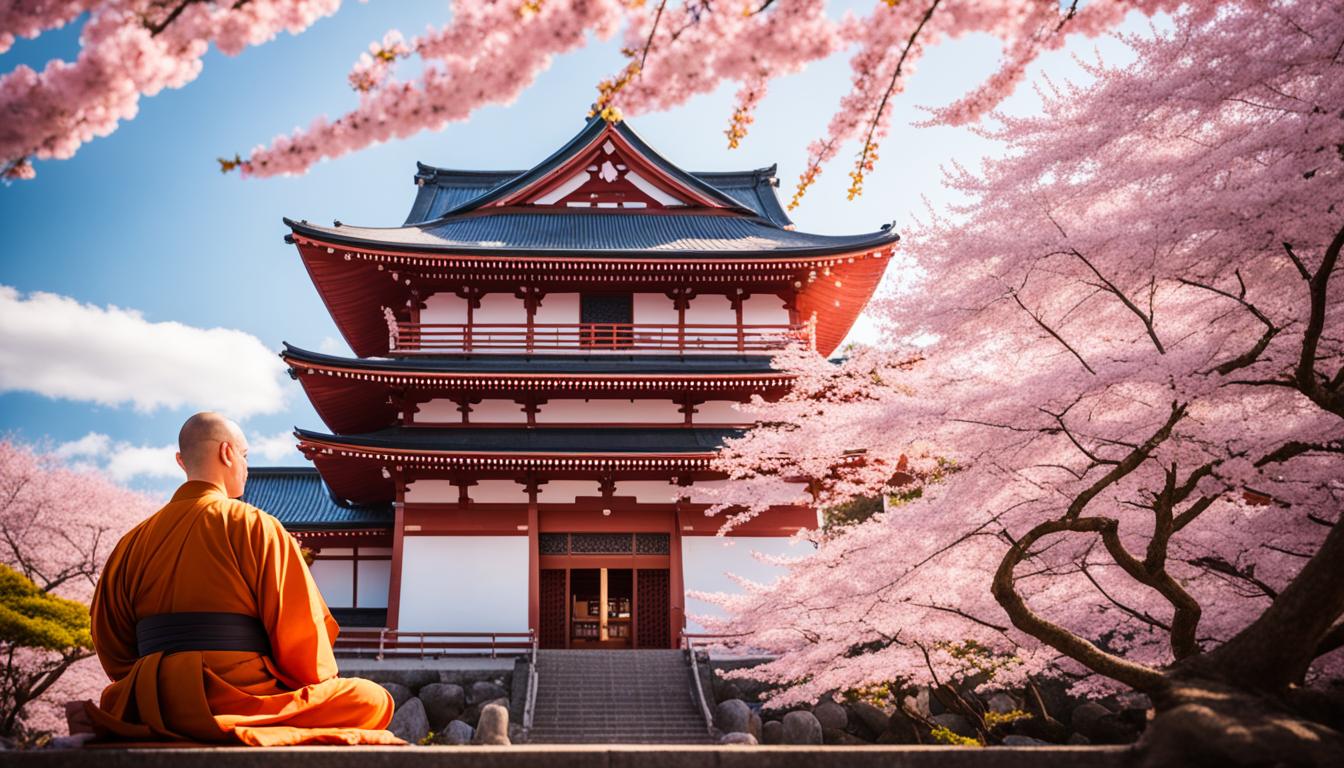Have you ever wondered about the essence of Japan’s culture and spiritual traditions? What is it that has shaped the minds and hearts of the Japanese people for centuries? The answer lies in the interwoven tapestry of Buddhism in Japan.
Buddhism, with its teachings of mindfulness, compassion, and personal growth, has had a profound impact on Japanese society. It has not only influenced religious practices but has also seeped into art, culture, and everyday life. So, what is it about Buddhism in Japan that resonates so deeply with its people?
In this article, we will delve into the rich history and intricate details of Buddhism in Japan. We will explore the spiritual practices, Zen temples, and the unique blend of Buddhism with Japan’s indigenous beliefs. Get ready to embark on a journey that will uncover the secrets of Buddhism in Japan and inspire you to embrace its profound wisdom.
Key Takeaways
- Discover the profound impact of Buddhism on Japanese culture and spirituality.
- Explore the history of Buddhism in Japan and its evolution into Zen.
- Uncover the core practices of Zen Buddhism, including seated meditation (Zazen).
- Understand the unique amalgamation of Buddhism and Shinto in Japan.
- Learn how Buddhism continues to thrive and address modern challenges in Japan.
The History of Buddhism in Japan
Buddhism has a rich and profound history in Japan, shaping its culture, spirituality, and artistic expression. The journey of Buddhism in Japan began in the 6th century when it was introduced from China as Chan Buddhism. Over time, it merged with Japan’s indigenous beliefs, giving rise to Zen Buddhism, a unique and influential branch that remains significant to this day.
During its development, Buddhist temples emerged as centers of spiritual learning and artistic exploration. These temples not only served as places of worship but also played a vital role in preserving and spreading Buddhist teachings. Buddhist monks, revered for their spiritual wisdom and dedication, guided the followers and ensured the longevity of Buddhist traditions.
Buddhist rituals and practices became deeply integrated into Japanese religious life. Meditation, an integral part of Buddhist practice, held a central position in the lives of followers. The study of Buddhist scriptures became a way to gain deeper insights into the teachings and principles of Buddhism.
Let’s take a closer look at the role of Buddhist temples, rituals, and monks in the history of Buddhism in Japan.
Buddhist Temples in Japan
Buddhist temples are not only places of worship but also treasures of art, history, and cultural heritage. These temples showcase exquisite architectural designs and intricate craftsmanship, reflecting the spiritual essence of Buddhism. They serve as sanctuaries for meditation, reflection, and the pursuit of enlightenment.
One notable example is the iconic Kinkaku-ji Temple, also known as the Golden Pavilion, located in Kyoto. Its stunning golden exterior and serene surroundings make it a popular destination for tourists and spiritual seekers alike. Another renowned temple is the Todai-ji Temple in Nara, home to the famous Great Buddha statue which stands as a symbol of Buddhist devotion and reverence.
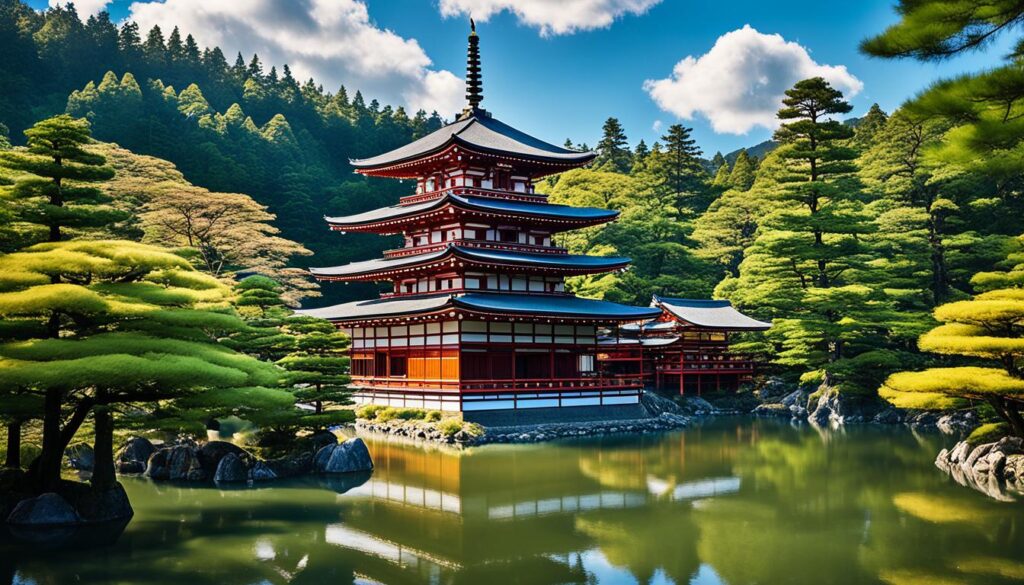
Buddhist Rituals in Japan
Buddhist rituals hold great significance in Japanese religious and cultural practices. These rituals provide a framework for expressing devotion, seeking spiritual guidance, and fostering a sense of community among followers. They serve as a means to honor ancestors, pray for prosperity, and seek blessings for personal well-being.
One notable ritual is the tea ceremony, which combines the principles of Buddhism, harmony, and aesthetics. This serene and mindful practice involves the preparation and serving of matcha tea with careful attention to every detail. Another important ritual is the Goma fire ritual, where prayers are offered by Buddhist monks, engulfed in flames, as a means of purification and protection from negative influences.
Buddhist Monks in Japan
Buddhist monks play a vital role in the history and practice of Buddhism in Japan. They dedicate their lives to religious study, meditation, and serving as spiritual guides for the community. The monks’ disciplined lifestyle and deep understanding of Buddhist teachings make them esteemed figures in Japanese society.
Monks engage in various activities within the temple, such as leading meditation sessions, conducting ceremonies, and providing guidance to followers seeking spiritual enlightenment. Their presence and wisdom create a supportive environment for individuals on their spiritual journey in the pursuit of inner peace and enlightenment.
Now that we have explored the history of Buddhism in Japan, the next section will delve into the significance of Zen Buddhism, its practices, and its influence on Japanese culture and art.
Zen Buddhism in Japan
Zen Buddhism, a branch of Mahayana Buddhism, has had a profound impact on the spiritual landscape of Japan. Its teachings and practices emphasize direct experience and insight, guiding followers to transcend conventional thinking and gain a deeper understanding of reality.
At the core of Zen Buddhism is the practice of Zazen, or seated meditation, which allows practitioners to cultivate mindfulness and focus their attention on the present moment. Through Zazen, individuals can develop a heightened awareness of their thoughts and emotions, leading to greater clarity and inner peace.
Zen monasteries and temples in Japan are renowned for their serene and minimalist architecture, creating an environment conducive to contemplation and reflection. These spiritual spaces often feature tranquil rock gardens, carefully arranged to evoke a sense of harmony and balance.
The disciplined lifestyle within Zen monastic communities further reflects the philosophy of Zen Buddhism. Monks and nuns follow a strict daily routine, engaging in meditation, chanting, and other rituals. This disciplined approach cultivates a deep sense of focus and dedication to the path of enlightenment.
Throughout history, Zen Buddhism has not only influenced the spiritual landscape of Japan but also permeated various art forms and cultural practices. From the iconic ink paintings of Zen masters to the traditional tea ceremonies guided by Zen principles, the essence of Zen can be found in many aspects of Japanese culture.
The Influence of Zen on Japanese Art
- Calligraphy: Zen calligraphy, known as “shodo,” is characterized by its minimalistic aesthetic and emphasis on the spontaneous expression of the artist’s inner state.
- Haiku Poetry: The brevity and focus on capturing the essence of the present moment in haiku poetry reflect Zen’s emphasis on mindfulness and direct experience.
- Ikebana: The art of flower arrangement, influenced by Zen principles, embodies the concepts of simplicity, harmony, and the appreciation of impermanence.
- Architecture: Zen-inspired architectural designs showcase an integration of natural elements, such as wood and stone, creating spaces that are in harmony with their surroundings.
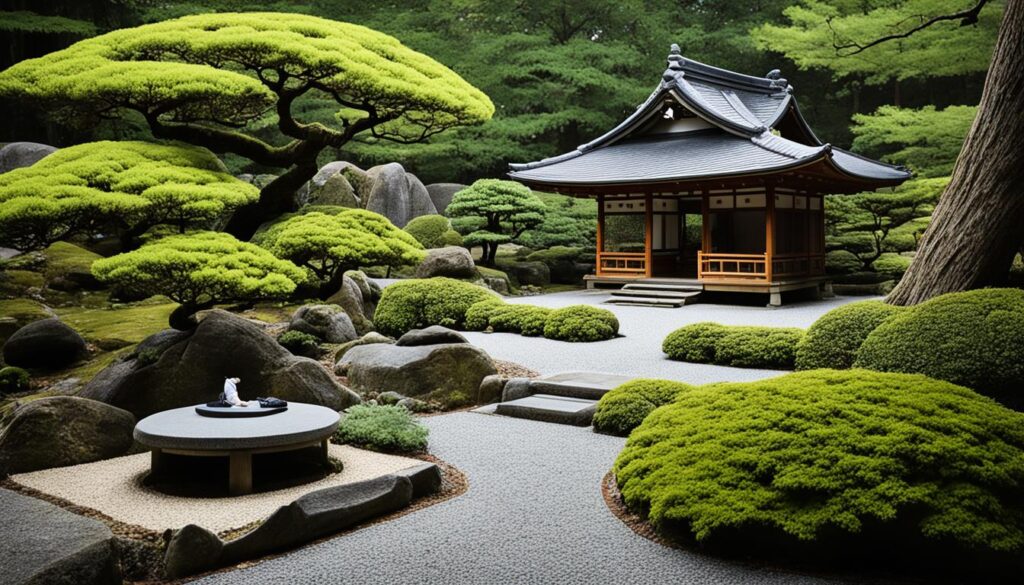
In summary, Zen Buddhism’s impact on Japan extends far beyond its spiritual practices. It has shaped the artistic expressions and cultural traditions of the country, creating a profound influence that continues to inspire and enrich the lives of many.
Buddhism and Japanese Culture
Buddhism has deeply influenced Japanese culture, intersecting with indigenous beliefs, particularly Shinto. The amalgamation of Buddhism and Shinto is known as Shinbutsu-shūgō and is a unique aspect of Japanese religious syncretism. Buddhist principles and rituals are integrated into various cultural practices, such as calligraphy, tea ceremonies, and martial arts. Buddhist temples and Zen gardens are not only places of worship but also renowned for their aesthetic simplicity and harmony.
The Syncretism of Buddhism and Shinto
In Japan, Buddhism and Shinto have a long history of coexistence and mutual influence. Shinto, the indigenous religion of Japan, focuses on the worship of nature and ancestral spirits. Buddhism, on the other hand, emphasizes personal enlightenment and the pursuit of spiritual awakening. Over the centuries, the two religions have merged, resulting in a unique blend of beliefs and practices.
The integration of Buddhism and Shinto is most evident in the concept of Shinbutsu-shūgō, where Buddhist and Shinto deities are enshrined together in the same temples or represented as a single divine entity. This syncretism reflects the harmonious coexistence and cultural integration that has shaped Japan’s religious landscape.
Cultural Practices and Artforms
Buddhist principles and rituals have permeated various aspects of Japanese culture, leaving a lasting impact on art, music, literature, and traditional practices. The influence of Buddhism can be seen in:
- Calligraphy: Buddhist scriptures and sutras are often written in ornate calligraphy styles, reflecting the reverence for the written word and the pursuit of spiritual enlightenment.
- Tea Ceremonies: The tea ceremony, rooted in Zen Buddhism, embodies mindfulness, tranquility, and the appreciation of beauty in simplicity.
- Martial Arts: Martial arts like kendo and aikido have deep connections to Zen Buddhism, emphasizing discipline, self-control, and the cultivation of inner strength.
These cultural practices not only serve as expressions of artistic beauty but also as vehicles for personal growth and spiritual development.
The Serenity of Buddhist Temples and Zen Gardens
Buddhist temples and Zen gardens are revered for their serene and harmonious environments. These spaces offer a sanctuary for quiet contemplation and reflection. Buddhist temples showcase exquisite architectural designs, characterized by intricate woodwork and serene aesthetics. Zen gardens, with their meticulously arranged rocks, gravel, and carefully pruned trees, represent a distilled essence of nature.
The beauty of these sacred places lies not only in their physical appearance but also in the sense of tranquility and peace they evoke. People visit Buddhist temples and Zen gardens to find solace, reconnect with nature, and seek spiritual insights.
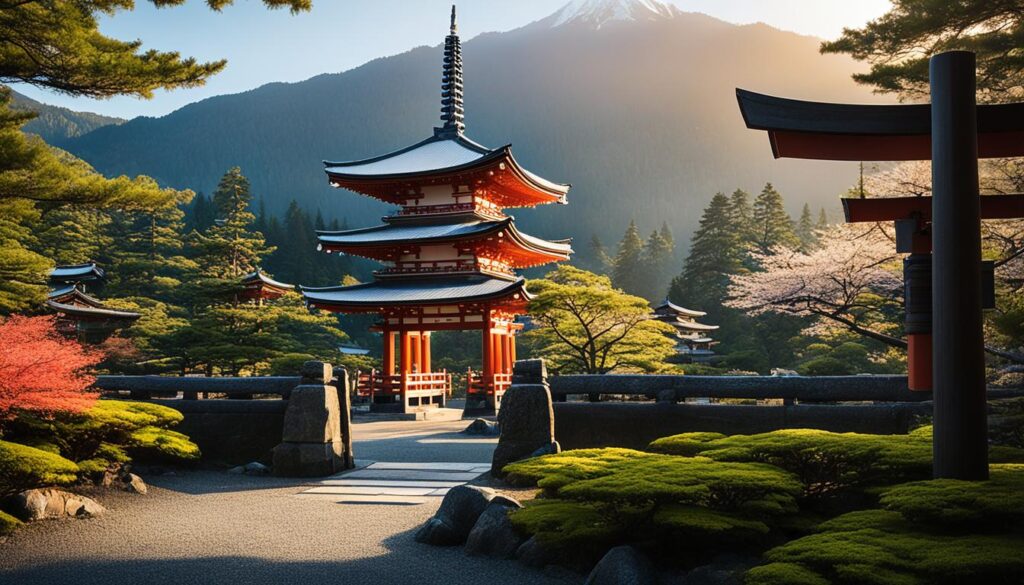
The image above showcases the tranquil beauty of a Zen garden, exemplifying the harmony found in the integration of Buddhism and Japanese culture.
Buddhism in Modern Japan
Buddhism in Japan has continuously evolved to meet the challenges of the modern world. Its teachings of mindfulness, compassion, and self-discovery hold deep relevance in a society grappling with stress, societal pressures, and environmental concerns. By embracing Buddhism in Japan, you open yourself to a transformative journey of inner growth and societal harmony.
Buddhist organizations in Japan are at the forefront of charitable activities, disaster relief efforts, and environmental conservation. They actively engage in initiatives that address the pressing needs of the communities, fostering compassion and a sense of interconnectedness.
Table: Buddhist Organizations and their Initiatives
| Buddhist Organization | Initiatives |
|---|---|
| Engaku-ji | Support for orphanages, homeless shelters, and educational programs |
| Todai-ji | Disaster relief efforts, providing aid to affected communities |
| Eko-in | Environmental conservation projects, promoting sustainable practices |
Buddhism’s emphasis on compassion extends beyond individual practice and manifests in broader societal transformations. By cultivating mindfulness and compassion, you contribute to the harmonious coexistence of individuals and communities, fostering a more compassionate and caring society.
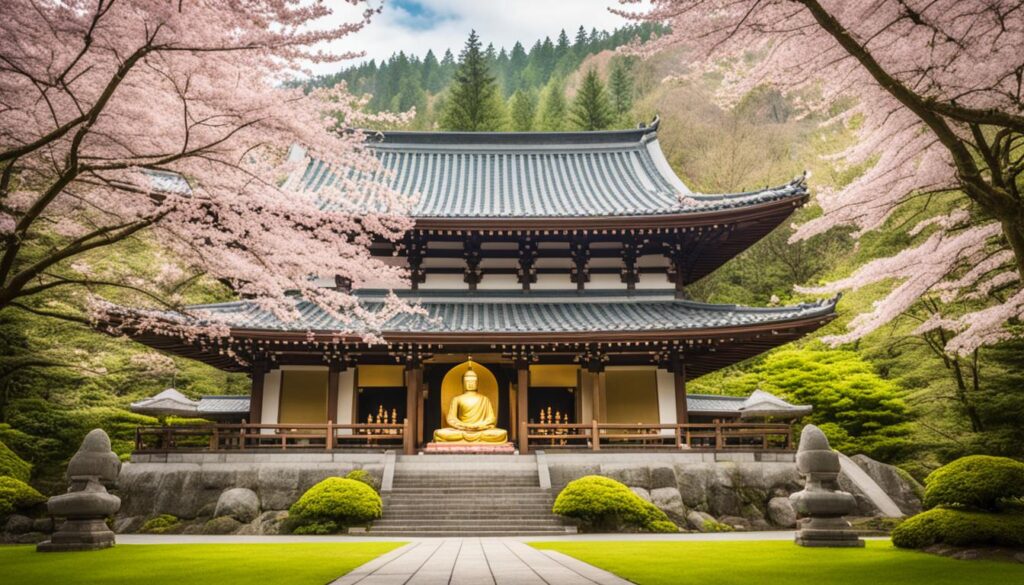
Conclusion
The rich and multifaceted tradition of Buddhism in Japan continues to inspire individuals around the world. From its ancient introduction to its seamless integration with Japanese culture, Japanese Buddhism offers profound teachings and practices for spiritual growth, mindfulness, and personal transformation. Embracing the spirit of Japanese Buddhism grants you an opportunity to immerse yourself in the tranquility of Buddhist temples, engage in Zen practices, and uncover the timeless wisdom that can guide you on a collective journey towards inner peace and harmony.
Buddhism in Japan is a testament to the enduring power of mindfulness and compassion. It serves as a vital resource for individuals seeking solace and a deeper understanding of themselves, the world, and their place in it. Whether you seek refuge in the meditative practices of Zen Buddhism, explore the harmonious fusion of Buddhism and Shinto, or imbibe the spiritual teachings found within Buddhist scriptures, Japanese Buddhism offers a myriad of paths to self-discovery and enlightenment.
As we navigate the complexities of modern life, Buddhism in Japan remains relevant and adaptable. Its teachings of interconnectedness and compassion provide invaluable insights for fostering personal well-being, fostering harmonious relationships, and promoting societal harmony in the face of ever-increasing stress, societal pressures, and environmental challenges. Through charitable activities, disaster relief efforts, and environmental conservation, Buddhist organizations in Japan actively contribute to creating a better world for all.
By embracing the teachings and practices of Buddhism in Japan, you embark on a transformative journey of self-discovery and spiritual growth. Step into the serene world of Buddhist temples, with their elegant architecture and serene gardens, to find solace and guidance. Engage in Zen practices like seated meditation (Zazen) to quiet the mind and experience profound clarity. With its timeless wisdom, Japanese Buddhism is a wellspring of inspiration, offering a path to inner peace, compassion, and harmony within ourselves and in our relationships with others.
FAQ
When was Buddhism introduced to Japan?
Buddhism was introduced to Japan from China as Chan Buddhism in the 6th century.
How did Buddhism evolve in Japan?
Buddhism gradually evolved in Japan, merging with the country’s indigenous beliefs and cultural heritage.
What role do Buddhist temples play in Japanese society?
Buddhist temples are centers of spiritual learning and artistic expression in Japan.
What are some Buddhist rituals and practices in Japan?
Meditation and the study of Buddhist scriptures are integral to Japanese religious life.
What is Zen Buddhism?
Zen Buddhism is a branch of Mahayana Buddhism that emphasizes direct experience and insight.
What is Zazen?
Zazen is seated meditation, which is a core practice of Zen Buddhism.
How has Zen Buddhism influenced Japanese culture?
Zen’s influence extends beyond meditation and permeates various art forms and cultural practices in Japan.
What is the relationship between Buddhism and Shinto in Japan?
Buddhism and Shinto have intersected in Japan, resulting in a unique religious syncretism called Shinbutsu-shūgō.
How does Buddhism address modern challenges in Japan?
Buddhist organizations in Japan actively engage in charitable activities, disaster relief efforts, and environmental conservation.
What insights does Buddhism offer for personal and societal harmony in modern Japan?
Buddhism’s emphasis on interconnectedness and compassion provides valuable insights for navigating stress and societal pressures.

